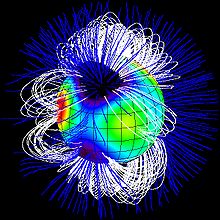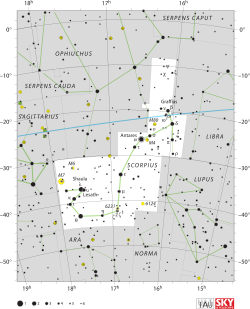Tau Scorpii
| Observation data Epoch J2000 Equinox J2000 | |
|---|---|
| Constellation | Scorpius
|
| Right ascension | 16h 35m 52.95285s[1] |
| Declination | −28° 12′ 57.6615″[1] |
| Apparent magnitude (V) | +2.82[2] |
| Characteristics | |
| Spectral type | B0.2 V[3] |
| U−B color index | −1.039[2] |
| B−V color index | −0.252[2] |
| Absolute magnitude (MV) | −4.2[5] |
| Details | |
Myr | |
| Database references | |
| SIMBAD | data |
Tau Scorpii,
Description

Compared to the
The
This star is a proper motion member of the Upper Scorpius subgroup of the
Scorpius–Centaurus OB association,
the nearest such co-moving association of massive stars to the Sun.[5][7]
The Upper Scorpius subgroup contains thousands of young stars with mean age 11 million years at average distance of 470 light years (145 parsecs)
Nomenclature
τ Scorpii (Latinised to Tau Scorpii) is the star's Bayer designation.
Tau Scorpii and Sigma Scorpii together bore the traditional name Al Niyat (or Alniyat) derived from the Arabic النياط al-niyāţ "the arteries" and referring to their position flanking the star Antares, the scorpion's heart, with Tau Scorpii being the star to the south.[16]
Paikauhale is the Hawaiian name for Tau Scorpii.[17][18] In the Hawaiian dictionary by Pukuʻi & Elbert (1986), the word paikauhale [ˈpəiˈkəuˈhale] is defined as to go gadding about from house to house. In another Hawaiian dictionary (H.W. Kent, 1993, "Treasury of Hawaiian Words in One Hundred and One Categories", p.367), paikauhale is defined as Vagabond owning no home; house-to-house wanderer.
In 2016, the IAU organized a Working Group on Star Names (WGSN)[19] to catalog and standardize proper names for stars. The WGSN approved the name Paikauhale for the star A on 10 August 2018 and it is now so included in the List of IAU-approved Star Names.[20] The name Alniyat was given to Sigma Scorpii.
Cultural signification
The indigenous Boorong people of northwestern Victoria saw this star (together with σ Sco) as wives of Djuit (Antares).[21]
In
References
- ^ S2CID 18759600
- ^ doi:10.1086/190168
- ^ S2CID 14115701
- Bibcode:1999VeARI..35....1W
- ^ Bibcode:1989A&A...216...44D
- ^ S2CID 118629873
- ^ S2CID 118461108.
- ^ Bibcode:1994A&A...282..867K
- ^ S2CID 14969137
- ^
- CDS ID [1]. Accessed on line February 8, 2013.
- ^ "tau Sco -- Star", SIMBAD, Centre de Données astronomiques de Strasbourg, retrieved 2010-08-01
- ^ "The Colour of Stars", Australia Telescope, Outreach and Education, Commonwealth Scientific and Industrial Research Organisation, December 21, 2004, archived from the original on 2013-12-03, retrieved 2012-01-16
- ^
- S2CID 7054292
- ISBN 0-486-21079-0.
- ^ Kawena, Johnson, & Ruggles, 2015, "Na Inoa Hoku: Hawaiian and Pacific Star Names", p.201
- ^ Puku'i & Elbert, 1986, "Hawaiian Dictionary: Hawaiian-English, English-Hawaiian", p.31
- ^ "IAU Working Group on Star Names (WGSN)". Retrieved 17 September 2018.
- ^ "IAU Catalog of Star Names". International Astronomical Union. Retrieved 2018-09-17.
- S2CID 118454721.
- ISBN 978-986-7332-25-7.
- ^ (in Chinese) 香港太空館 - 研究資源 - 亮星中英對照表 Archived 2008-10-25 at the Wayback Machine, Hong Kong Space Museum. Accessed on line November 23, 2010.

